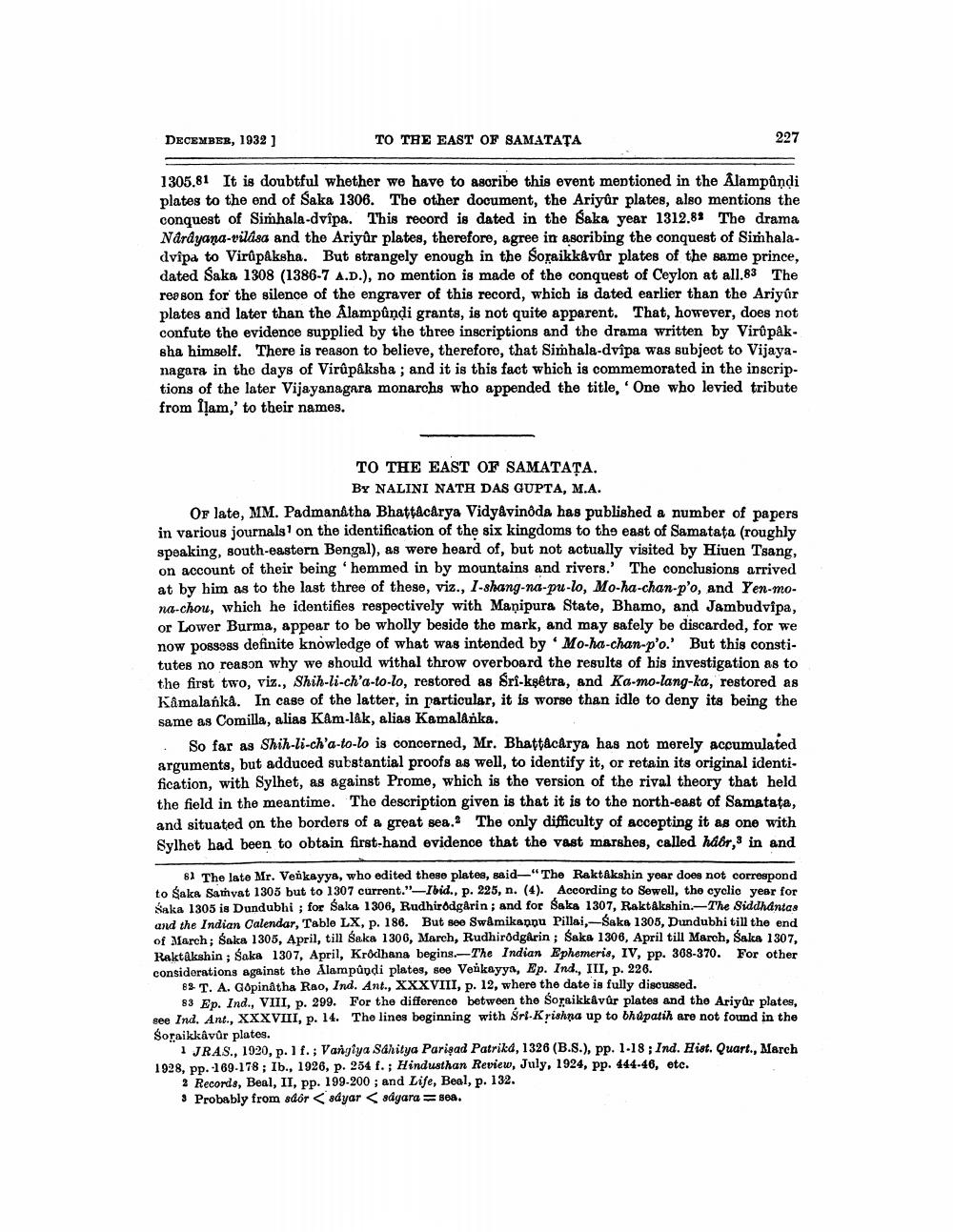________________
DECEMBER, 1932 ]
TO THE EAST OF SAMATATA
227
1305.81 It is doubtful whether we have to ascribe this event mentioned in the Alampûndi plates to the end of Saka 1306. The other document, the Ariyûr plates, also mentions the conquest of Simhala-dvipa. This record is dated in the Saka year 1312.88 The drama Nardyana-vilása and the Ariyûr plates, therefore, agree in ascribing the conquest of Simhaladvipa to Virupaksha. But strangely enough in the Soraikkavûr plates of the same prince, dated Saka 1308 (1386-7 A.D.), no mention is made of the conquest of Ceylon at all.83 The reason for the silence of the engraver of this record, which is dated earlier than the Ariyúr plates and later than the Alampundi grants, is not quite apparent. That, however, does not confute the evidence supplied by the three inscriptions and the drama written by Virûpåksha himself. There is reason to believe, therefore, that Simhala-dvîpa was subject to Vijayanagara in the days of Virupaksha ; and it is this fact which is commemorated in the inscriptions of the later Vijayanagara monarchs who appended the title, 'One who levied tribute from Ilam,' to their names.
TO THE EAST OF SAMATAȚA.
BY NALINI NATH DAS GUPTA, M.A. Of late, MM. Padmanatha Bhattacarya Vidyavinoda has published a number of papers in various journals on the identification of the six kingdoms to the east of Samatata (roughly speaking, south-eastern Bengal), as were heard of, but not actually visited by Hiuen Tsang, on account of their being 'hemmed in by mountains and rivers. The conclusions arrived at by him as to the last three of these, viz., 1-shang-na-pu-lo, Mo-ha-chan-p'o, and Yen-mona-chou, which he identifies respectively with Manipura State, Bhamo, and Jambudvipa, or Lower Burma, appear to be wholly beside the mark, and may safely be discarded, for we now possess definite knowledge of what was intended by 'Mo-ha-chan-p'o. But this constitutes no reason why we should withal throw overboard the results of his investigation as to the first two, viz., Shih-li-ch'a-to-lo, restored as Sri-kşetra, and Ka-mo-lang-ka, restored as Kamalańka. In case of the latter, in particular, it is worse than idle to deny its being the same as Comilla, alias Kám-lak, alias Kamalänka.
So far ag Shih-li-ch'a-to-lo is concerned, Mr. Bhattacarya has not merely accumulated arguments, but adduced substantial proofs as well, to identify it, or retain its original identi. fication, with Sylhet, as against Prome, which is the version of the rival theory that held the field in the meantime. The description given is that it is to the north-east of Samatata, and situated on the borders of a great sea. The only difficulty of accepting it as one with Sylhet had been to obtain first-hand evidence that the vast marshes, called habr, in and
81 The late Mr. Venkayya, who edited these plates, said—"The Raktákshin year does not correspond to Saka Samvat 1305 but to 1307 current."-Ibid., p. 225, n. (4). According to Sowell, the cyclio year for Saka 1305 is Dundubhi ; for Saka 1306, Rudhirädgårin; and for Saka 1307, Rakt Akshin-The Siddhantas and the Indian Calendar, Table LX, p. 186. But see Swamikappu Pillai,- Saka 1305, Dundubhi till the end of March; Saka 1305, April, till Saka 1306, March, Rudhirodgerin; Saka 1306, April till March, Saka 1307, Raktákshin ; Soka 1307, April, Krodhana begins.-The Indian Ephemeris, IV, pp. 308-370. For other considerations against the Alampu di plates, see Veikayya, Ep. Ind., III, p. 226.
88 T. A. Gopinatha Rao, Ind. Ant., XXXVIII, p. 12, where the date is fully discussed.
83 Ep. Ind., VIII, p. 299. For the difference between the Soraikkavur plates and the Ariyor plates, see Ind. Ant., XXXVIII, p. 14. The lines beginning with Sri Krishna up to bhupatih are not found in the Soraikkâvûr plates.
1 JRAS., 1920, p. 1f.; Vangiya Sahitya Parişad Patrikd, 1326 (B.S.), pp. 1.18; Ind. Hist. Quart., March 1928, pp. 169-178; Ib., 1926, p. 284 f.; Hindusthan Review, July, 1924, pp. 444-46, etc.
2 Records, Beal, II, pp. 199-200; and Life, Beal, p. 132. 3 Probably from sdôr <sdyar <sdgara = sea.




